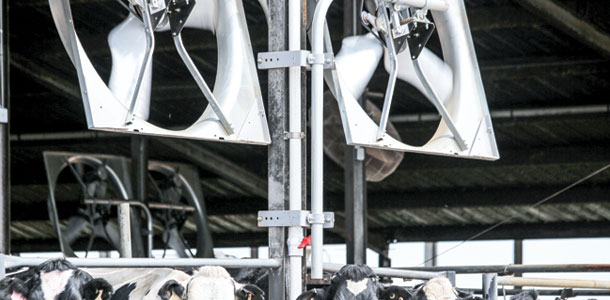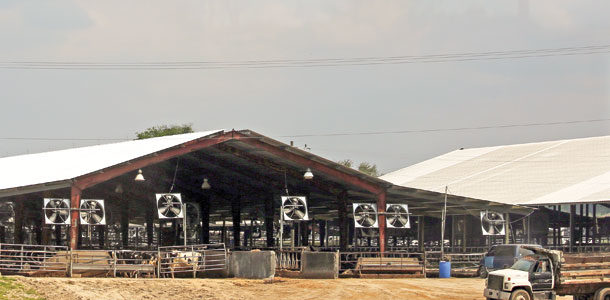How do 6,000 cows beat the heat during Florida’s dog days of summer? “We live and die by our fans and sprinklers and making sure they are operating correctly,” says Jan Henderson, who left the financial industry to become chief financial officer and the next generation working into the partnership with her father, Ron St. John, at Alliance Dairies in Trenton, Florida.
“July through September are the worst. We average more than 78 days a year where the heat index exceeds 95 degrees [Fahrenheit],” she relates. “In the morning it can be 74 degrees at 7 a.m., and the air is so thick with humidity a brisk 10-minute walk will break a good sweat. When it is 70 degrees or warmer in the morning, there is continuous heat stress on the cow because she didn’t get a break overnight.”
In the freestall barns and parlor, fans are set to come on when the temperature reaches 60ºF, and they stay on until it dips below 60ºF. “We’ve already been running our fans since March almost continuously,” Henderson explains.
When temperatures reach 70ºF, the sprinklers come on automatically to run one minute out of 10, and at 80ºF, they run two minutes out of 10.
Each side of each six-row barn is lined with four rows of fans running the length of the barn. A line of fans is situated over the outside stalls with a fan over each line of face-to-face freestalls and another line at the feedbunks. Sprinklers are placed at the feed faces and in the holding area. Additional fans are placed over the cows in the parlor and the holding area.
Everything from the barns to the parlor is naturally ventilated, but to move more air over the cattle for more effective evaporative cooling, Alliance Dairies has begun retrofitting to move away from the 36-inch basket fans to the 52-inch cast aluminum fans with the larger 1.5 hp motors.
“The new fans are placed every 60 feet, and we measured the wind speed at the last freestall at 8 mph,” Henderson explains. “This means the last stall in each fan-group is still reaching close to the ideal of 10 mph.”
Moving to the larger fans, equipped with three times the horsepower, has reduced the total number of fans by placing them every 60 feet instead of every 20 to 30 feet. Not only is it more energy-efficient, cow cooling has improved, according to Henderson.
The entire cow herd under roof numbers close to 6,000, with 4,900 to 5,200 milking at any given time. Sprinklers are monitored to ensure no “dead areas” so there is an even flow no matter where the cattle are standing along the feed face.
“We push out refusals twice a day to keep feed fresh in the summer,” Henderson says. “Waterers are placed along the lane to and from the parlor, and we clean all waterers regularly.”

Water is also recycled here continuously. Fresh water goes for drinking, sprinklers and the parlor, and then is re-used in the manure flush to clean the barns. The flush ends up in the lagoon to be pulled for spray irrigation of cropfields.
“We do cool our dry cows,” Henderson confirms, citing University of Florida research on how it pays. “In 2012, we took control of a neighboring dairy facility that had shut down and started using the freestall barns for our dry cows. With the University of Florida study, we tried to determine if we would see a difference between cows cooled with just fans or with both fans and sprinklers.”
Her takeaway from the study was to set thermostats warmer for dry cows than for milk cows. The fans come on at temperatures of 70ºF (versus 60ºF for milk cows), and it hits 80ºF before they start using water on their backs for evaporative cooling.
“We do have sprinklers there, so we use them at 80 degrees for the dry cows, running one minute out of 10,” Henderson reports, adding that the 36-inch basket fans are still being used at that facility, with plans to upgrade to the 52-inch in the future.
Fans and sprinklers are automated, but employees walking through the barns are vigilant about reporting any problems to the dairy’s electrician.
“That’s critical,” says Henderson. “July through September is our survival mode. We hope to have less than a 10-pound swing in milk production from our peak to our low on a per-cow-per-day basis. We don’t like to see them get below 70 pounds.”
In mid-June, the herd produced 79 pounds per cow per day.
If the springtime is any indication of the summer that has arrived early, it will likely be a hot one. They started chopping corn silage on June 15 – the earliest ever – due to a very warm spring that has matured the crop quickly even though planting was not early.
While they calve year-round, Henderson says they stop using sexed semen in the summer months. “We found our pregnancy rates vary by 12 percent from the hot months to the cooler months, so giving up sexed semen during that time helps us manage that variation.”
Bigger fans putting out faster wind speeds, twice-a-day feed pushout, dry cow cooling and thermostatically controlled sprinklers are investments of time and money that are working.
“The University of Florida found an extra 11 pounds of milk per cow by cooling dry cows. Our herd right now is as healthy as ever, and production is higher than it’s ever been,” Henderson reports. The combination of management improvements, bigger fans and cooling dry cows have all positively impacted Alliance Dairies.
Other than that, she adds: “We pray for a late spring and an early fall.” PD
Sherry Bunting is a freelance writer based in East Earl, Pennsylvania.
PHOTO 1: In March, Alliance Dairies was in the process of replacing fans in the naturally ventilated freestall barns to use the larger 52-inch 1.5 hp fans. This completed retrofit shows the placement of four lines of fans on each side of a six-row barn: a line of fans over the outside stalls, two lines of fans over the face-to-face stalls and a line of fans over the feedbunk, where thermostatically controlled sprinklers provide the first step in evaporative cooling.
PHOTO 2: Larger, more energy-efficient fans like these move more air over the cattle for evaporative cooling. Photos courtesy of Sherry Bunting.








